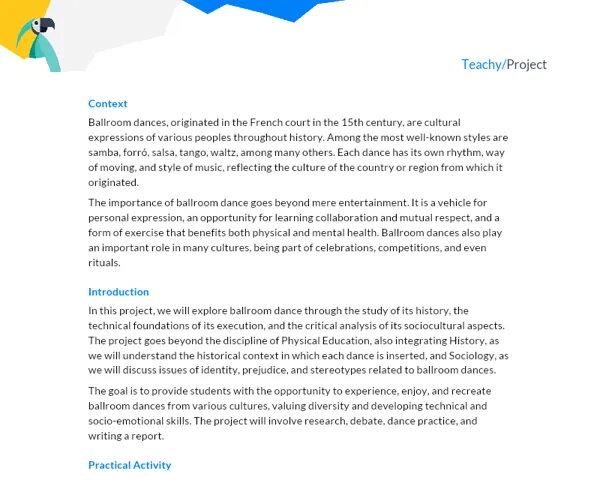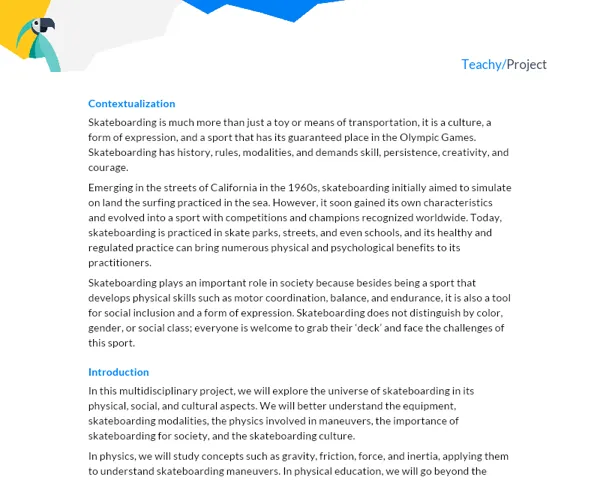Contextualization
Sports is a cultural practice that has existed for thousands of years, evolving and adapting over time to the specific needs and conditions of the societies in which it was embedded. Its origins date back to Antiquity, when the first Olympic Games were held in ancient Greece, around 776 BC. Since then, sports have become a globally significant phenomenon, not only as a physical activity but also as a means of cultural expression, socialization, and a multibillion-dollar business.
The history of sports is rich and varied, encompassing a wide range of activities, from the simplest to the most complex, many of which have stood the test of time and continue to be practiced today. Moreover, it is a history marked by a series of transformations that reflect the social, technological, and cultural changes that have occurred over time.
In-depth investigation of the history of sports allows for a more comprehensive understanding of how human societies have valued sports and physical activity, and how these practices have contributed to the formation of individual and collective identities, the promotion of health and well-being, and the building of social and cultural bonds.
The history of sports also plays an important role in physical education, contributing to the development of a critical perspective on sports practice and physical education as a discipline. By understanding the origins, evolution, and cultural significance of sports, students have the opportunity to reflect on their own sports practice and the importance of sports in their lives and in society.
To begin exploring this topic, I suggest that you use the following resources:
-
SANTOS, M. M. dos. Physical Education in Schools: Sports as Pedagogical Content. Revista Paulista de Educação Física, São Paulo, Supl. 4, p.53-61, 2001. (Article available at: http://www.scielo.br/scielo.php?script=sci_arttext&pid=S1517-86922001000500007).
-
VARGAS, Gilberto de Barros. Physical Education and Sports in Antiquity. Revista Brasileira de Educação Física e Esporte, v. 22, n. 1, p. 73-89, 2008. (Article available at: http://www.scielo.br/scielo.php?script=sci_arttext&pid=S1807-55092008000100007).
-
Tubino, Manoel José Gomes. What is sports. 3rd ed. São Paulo, Brasiliense, 1993. (Book available in many libraries and used bookstores).
Practical Activity
Activity Title: "Revealing the History of Sports"
Project Objective
The objective of this project is to develop in students an understanding of the origin and evolution of sports, as well as the ability to work in teams, conduct research, and present information in a creative and engaging way.
Project Description
Students will be divided into groups of 3 to 5 members. Each group will be responsible for investigating the history of a specific sport. This sport can be one of the most well-known and practiced worldwide, such as soccer, basketball, volleyball, athletics, among others.
Groups should research the origin of the sport, its evolution over time, the main rules, the equipment used, the most important competitions, and the most prominent athletes. In addition, groups should explore the cultural and social relevance of the chosen sport, its influence on identity formation, and its impact on contemporary society.
Required Materials
- Computer with internet access for research.
- Presentation materials (PowerPoint, Poster, etc).
Project Step-by-Step
- Divide into groups of 3 to 5 members.
- Choose a sport to research. Try to choose a sport that everyone in the group is interested in.
- Research the history of the chosen sport. Look for information about its origin, evolution, rules, events, important athletes, etc.
- Prepare a presentation about the chosen sport. The presentation should be creative and informative, covering all aspects researched by the group. You can use PowerPoint, create a poster, a video, etc.
- Present the work to the class.
Project Deliverables
At the end of the week, each group must deliver:
- A presentation on the history of the chosen sport.
- A written report on the project. The report should include an introduction contextualizing the chosen sport, the development with the theory behind the sport, the activity and methodology used, and the conclusion with the learnings obtained. Remember to include in the conclusion the learnings about the sport and teamwork. The report should also include a bibliography with all the sources used in the research.
The report and the presentation are complementary parts of the project. The presentation is a way to express in a playful and creative manner the information found in the research, while the report formalizes the research and learning process, where you should express clearly and organized all the information acquired in the project.



